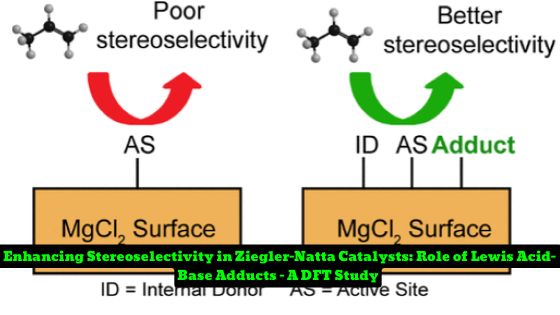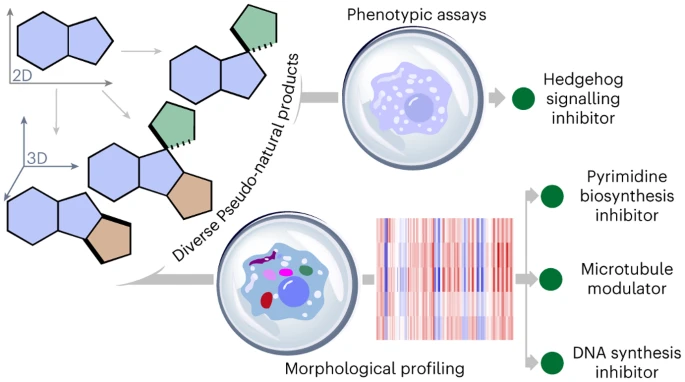A recent paper published in the Journal of Physical Chemistry C titled “The Potential Role of Lewis Acid−Base Adducts in Enhancing Stereoselectivity in Ziegler−Natta Catalysts: A DFT Study” reveals that Lewis acid-base adducts formed by alkoxysilane donors and aluminum species can enhance the stereoselectivity in Ziegler-Natta (ZN) systems.
What is the study about?
The study investigates the feasibility of the formation of Lewis acid-base adducts between four alkoxysilane donors and AlEt3 or AlEt2Cl using full quantum chemical calculations with density functional theory. The aim is to understand the potential role of these adducts in enhancing stereoselectivity in ZN catalysts.
What did the researchers find?
The study found that alkoxysilane donors prefer to bind away from the active site (AS) due to favorable chelate coordination. However, the presence of Lewis acid-base adducts can lead to bridge coordination next to the AS, which can enhance stereoselectivity in ZN systems. The researchers also found that the formation of ASs by coordinating DCPDMS and DSBDMS is feasible in ZN catalysis systems.
Why is this study important?
ZN catalysts are widely used in the production of polyolefins, and enhancing their stereoselectivity can improve the quality and properties of the resulting products. The study provides insights into the potential role of Lewis acid-base adducts in improving stereoselectivity, which can have implications for the development of more efficient ZN catalysts.
In conclusion, the comprehensive computational studies conducted in this paper indicate that the formation of Lewis acid-base adducts between alkoxysilane donors and aluminum species has the potential to improve stereoselectivity in ZN systems. This study opens up new avenues for the development of more efficient ZN catalysts that can produce high-quality polyolefins.
Core Q&A related to this research
What is the aim of the study conducted in this paper?
Answer: The aim of this study is to investigate the potential role of Lewis acid-base adducts in enhancing stereoselectivity in Ziegler-Natta (ZN) catalysts using DFT calculations.
What are the external donors considered in this study?
Answer: The four external donors considered in this study are DIPDMS, DCPDMS, DSBDMS, and SBMDMS.
Why does an alkoxysilane donor prefer to bind away from the AS?
Answer: An alkoxysilane donor prefers to bind away from the AS due to the favorable chelate coordination.
What is the potential of Lewis acid-base adducts formed by alkoxysilane donors and aluminum species?
Answer: According to the comprehensive computational studies in this paper, the Lewis acid-base adducts formed by alkoxysilane donors and aluminum species have the potential to improve the stereoselectivity in ZN systems.
What level of theory was used to optimize the re- and si-TSs for 1,2-insertion in this study?
Answer: The cost-effective M06-2X/TZVP level of theory was used to optimize the re- and si-TSs for 1,2-insertion in this study.
Basic Q&A related to this research
Q: What is meant by Lewis acid?
A: Lewis acid is a chemical species that can accept a pair of electrons to form a covalent bond with a Lewis base.
Q: What are base adducts in the context of the above data?
A: Base adducts are chemical species formed by the reaction between a Lewis acid and a Lewis base, where the base donates a pair of electrons to the acid to form a covalent bond.
Q: What is stereoselectivity?
A: Stereoselectivity refers to the ability of a chemical reaction to produce a specific stereoisomer over other possible stereoisomers.
Q: What are Ziegler-Natta catalysts?
A: Ziegler-Natta catalysts are coordination compounds used in the polymerization of olefins, which have the ability to produce polymers with specific stereochemistries.
Q: What is a DFT study?
A: DFT stands for density functional theory, which is a computational method used to calculate the electronic structure and properties of molecules and materials.
Q: What are quantum chemical calculations?
A: Quantum chemical calculations are computational methods used to study the behavior of molecules and materials at the quantum mechanical level.
Q: What is the MgCl2 surface in the context of the above data?
A: The MgCl2 surface refers to the surface of a magnesium chloride crystal, which is a common component in Ziegler-Natta catalysts.
Q: What are aluminum species in the context of the above data?
A: Aluminum species are chemical species containing aluminum atoms, which can interact with the MgCl2 surface and alkoxysilane donors in Ziegler-Natta catalysts.
Q: What are decomposition reactions in the context of the above data?
A: Decomposition reactions are chemical reactions where a compound breaks down into simpler compounds or elements.
Q: What are alkoxysilane donors?
A: Alkoxysilane donors are external donors used in Ziegler-Natta catalysts to improve the stereoselectivity of the polymerization reaction.
Q: What is chelate coordination?
A: Chelate coordination is a type of bonding in which a ligand forms a ring with a metal ion by donating two or more electron pairs to the ion.
Q: What is bridge coordination?
A: Bridge coordination is a type of bonding in which a ligand spans two or more metal ions by donating one or more electron pairs to each ion.
Q: What is AS in the context of the above data?
A: AS stands for aluminum species, which are chemical species containing aluminum atoms that can interact with alkoxysilane donors in Ziegler-Natta catalysts.
Q: What is AlEt3?
A: AlEt3 is a chemical species containing aluminum atoms and ethyl groups, which is commonly used in Ziegler-Natta catalysts.
Q: What is AlEt2Cl?
A: AlEt2Cl is a chemical species containing aluminum atoms, ethyl groups, and chloride ions, which is commonly used in Ziegler-Natta catalysts.
Q: What is the (110) MgCl2 surface in the context of the above data?
A: The (110) MgCl2 surface refers to a specific crystal plane of a magnesium chloride crystal, which is of particular interest in Ziegler-Natta catalysis.
Q: What is chirality?
A: Chirality is a property of molecules that have a non-superimposable mirror image, which can give rise to different stereoisomers.
Q: What are re-TSs and si-TSs in the context of the above data?
A: re-TSs and si-TSs refer to transition states in chemical reactions




